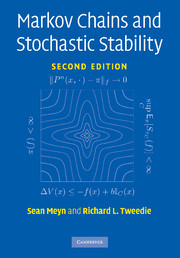Book contents
- Frontmatter
- Contents
- List of figures
- Prologue to the second edition
- Preface to the second edition
- Preface to the first edition
- I COMMUNICATION and REGENERATION
- II STABILITY STRUCTURES
- 8 Transience and recurrence
- 9 Harris and topological recurrence
- 10 The existence of π
- 11 Drift and regularity
- 12 Invariance and tightness
- III CONVERGENCE
- IV APPENDICES
- Bibliography
- General index
- Symbols
10 - The existence of π
Published online by Cambridge University Press: 05 August 2012
- Frontmatter
- Contents
- List of figures
- Prologue to the second edition
- Preface to the second edition
- Preface to the first edition
- I COMMUNICATION and REGENERATION
- II STABILITY STRUCTURES
- 8 Transience and recurrence
- 9 Harris and topological recurrence
- 10 The existence of π
- 11 Drift and regularity
- 12 Invariance and tightness
- III CONVERGENCE
- IV APPENDICES
- Bibliography
- General index
- Symbols
Summary
In our treatment of the structure and stability concepts for irreducible chains we have to this point considered only the dichotomy between transient and recurrent chains.
For transient chains there are many areas of theory that we shall not investigate further, despite the flourishing research that has taken place in both the mathematical development and the application of transient chains in recent years. Areas which are notable omissions from our treatment of Markovian models thus include the study of potential theory and boundary theory [326], as well as the study of renormalized models approximated by diffusions and the quasi-stationary theory of transient processes [108, 4].
Rather, we concentrate on recurrent chains which have stable properties without renormalization of any kind, and develop the consequences of the concept of recurrence. In this chapter we further divide recurrent chains into positive and null recurrent chains, and show here and in the next chapter that the former class provide stochastic stability of a far stronger kind than the latter.
For many purposes, the strongest possible form of stability that we might require in the presence of persistent variation is that the distribution of Φn does not change as n takes on different values. If this is the case, then by the Markov property it follows that the finite dimensional distributions of Φ are invariant under translation in time. Such considerations lead us to the consideration of invariant measures.
- Type
- Chapter
- Information
- Markov Chains and Stochastic Stability , pp. 229 - 255Publisher: Cambridge University PressPrint publication year: 2009

